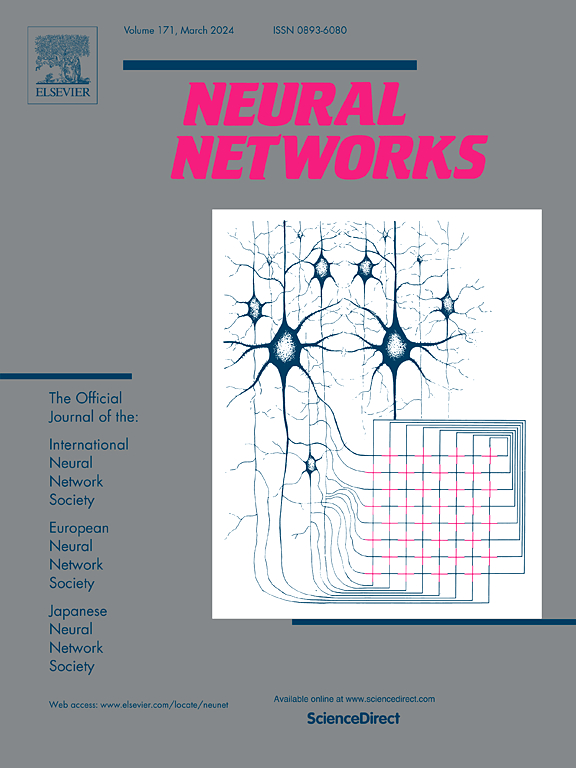基于知识蒸馏的单步峰值siamfc++对象跟踪
IF 6
1区 计算机科学
Q1 COMPUTER SCIENCE, ARTIFICIAL INTELLIGENCE
引用次数: 0
摘要
尖峰神经网络(SNNs)采用二进制尖峰方式传输信息,具有效率高、能耗低的优点。目前,snn的多个时间步长会导致延迟和功耗增加。为此,我们提出了单步spike siamfc++ (S4),这是一种改进的单步端到端直接训练目标跟踪框架,使用AlexNet作为骨干网,通过时间剪枝将时间步长压缩为1。实验结果表明,即使只使用单个时间步长,所提出的S4的跟踪性能仍可与原始的Spiking siamfc++相媲美。此外,我们引入了知识蒸馏来提高所提出的S4的性能,为了清晰起见,我们将其称为S4- kd。针对S4-KD设计了三种不同的蒸馏损失函数。基于AlexNet网络的人工神经网络模型作为教师模型,时间修剪的S4模型作为学生模型进行再训练。实验结果表明,S4-KD跟踪器在多个跟踪基准测试中取得了较高的性能。具体来说,在OTB100数据集上,Precision和Success分别为0.871和0.657,在UAV123数据集上,Precision和Success分别为0.766和0.603,在VOT2018数据集上,A、R和EAO分别为0.582、0.370和0.278。此外,S4-KD的估计能耗仅为原始Spiking siamfc++的34.6%。据我们所知,所提出的S4-KD跟踪器超越了所有现有的基于snn的目标跟踪方法,实现了最先进的性能。我们的代码将在https://github.com/PSNN-xd/S4-KD上提供。本文章由计算机程序翻译,如有差异,请以英文原文为准。
S4-KD: A single step spiking SiamFC+ + for object tracking with knowledge distillation
Spiking neural networks (SNNs), which transmit information through binary spikes, have the advantages of high efficiency and low energy consumption. At present, the multiple time steps of SNNs can lead to increased latency and power consumption. To this end, we propose Single Step Spiking SiamFC+ + (S4), an improved single-step end-to-end direct training target tracking framework that compresses the time step to 1 by temporal pruning, using AlexNet as the backbone network. Experimental results show that, even when only a single time step is used, the tracking performance of the proposed S4 is still comparable to the original Spiking SiamFC+ +. Furthermore, we introduce the knowledge distillation to improve the performance of the proposed S4, which is called S4-KD for clarity. Three kinds of distillation loss functions are designed for the S4-KD. An artificial neural network model based on the AlexNet network serves as the teacher model, while the temporal-pruned S4 model acts as the student model for retraining. Experimental results show that the S4-KD tracker achieves higher performance on several tracking benchmarks. More specifically, on the OTB100 dataset, Precision and Success are 0.871 and 0.657 respectively, on the UAV123 dataset, Precision and Success are 0.766 and 0.603 respectively, and on the VOT2018 dataset, A, R, and EAO are 0.582, 0.370, and 0.278 respectively. In addition, the estimated energy consumption of the S4-KD is only 34.6 % of that of the original Spiking SiamFC+ +. To the best of our knowledge, the proposed S4-KD tracker surpasses all the existing SNN-based object tracking methods, achieving state-of-the-art performance. Our codes will be available at https://github.com/PSNN-xd/S4-KD.
求助全文
通过发布文献求助,成功后即可免费获取论文全文。
去求助
来源期刊

Neural Networks
工程技术-计算机:人工智能
CiteScore
13.90
自引率
7.70%
发文量
425
审稿时长
67 days
期刊介绍:
Neural Networks is a platform that aims to foster an international community of scholars and practitioners interested in neural networks, deep learning, and other approaches to artificial intelligence and machine learning. Our journal invites submissions covering various aspects of neural networks research, from computational neuroscience and cognitive modeling to mathematical analyses and engineering applications. By providing a forum for interdisciplinary discussions between biology and technology, we aim to encourage the development of biologically-inspired artificial intelligence.
 求助内容:
求助内容: 应助结果提醒方式:
应助结果提醒方式:


